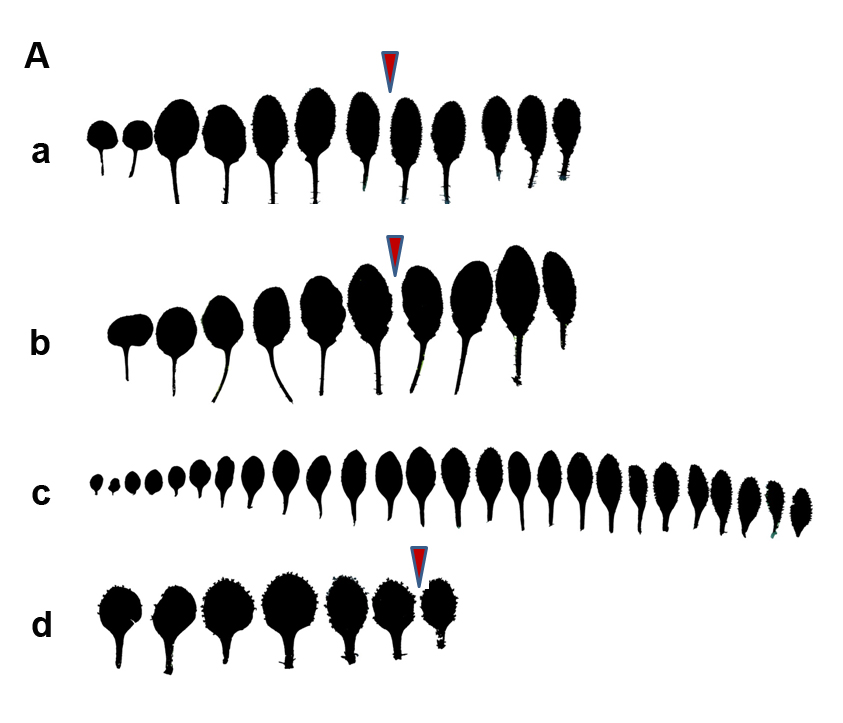

The Effect of Leaf Number-altered Mutants in Arabidopsis thaliana
? These authors contributed equally to this paper
Received date: 2014-04-02
Accepted date: 2014-05-19
Online published: 2015-04-08
The vegetative growth of Arabidopsis thaliana includes a juvenile phase and an adult phase. The transition from the juvenile phase to the adult phase (vegetative phase change, VPC) is associated with changes in several morphological features of leaves, the shape of the shoot apical meristem, the onset of abaxial trichome and the expression of transcription factors like squamosa promoter-binding protein-like family. Recently, signals that promote VPC were found to be derived from leaf primordium. To explore the effect of leaf number on VPC, we analyzed the VPC processes with two types of rosette leaf-altered mutants and defoliated wild-type plants. We found that decreasing number of rosette leaves delayed vegetative phase change. However, the amp1-1 mutant, with increased number of rosette leaves, does not promote VPC. We proposed that photosynthesis may affect the transition of the leaf-derived signals, regulating VPC.

Hong Long , Yang Lu . The Effect of Leaf Number-altered Mutants in Arabidopsis thaliana[J]. Chinese Bulletin of Botany, 2015 , 50(3) : 331 -336 . DOI: 10.3724/SP.J.1259.2015.00331
| 1 | 高英, 郭建强, 赵金凤 (2011). 拟南芥表皮毛发育的分子机制. 植物学报 46, 119-127. |
| 2 | Amasino RM, Michaels SD (2010). The timing of flowering.Plant Physiol 154, 516-520. |
| 3 | Andrés F, Coupland G (2012). The genetic basis of flowering responses to seasonal cues.Nat Rev Genet 13, 627-639. |
| 4 | Chien JC, Sussex IM (1996). Differential regulation of trichome formation on the adaxial and abaxial leaf surfaces by gibberellins and photoperiod in Arabidopsis thaliana (L.) Heynh.Plant Physiol 111, 1321-1328. |
| 5 | Cookson SJ, Chenu K, Granier C (2007). Day length affects the dynamics of leaf expansion and cellular deve- lopment in Arabidopsis thaliana partially through floral transition timing.Ann Bot 99, 703-711. |
| 6 | Huijser P, Schmid M (2011). The control of developmental phase transitions in plants.Development 138, 4117-4129. |
| 7 | Martínez-Zapater JM, Jarillo JA, Cruz-Alvarez M, Roldán M, Salinas J (1995). Arabidopsis late-flowering fve mutants are affected in both vegetative and reproductive development.Plant J 7, 543-551. |
| 8 | Matsoukas IG, Massiah AJ, Thomas B (2013). Starch metabolism and antiflorigenic signals modulate the juvenile-to-adult phase transition in Arabidopsis.Plant Cell Environ 36, 1802-1811. |
| 9 | Poethig RS (2013). Vegetative phase change and shoot maturation in plants.Curr Top Dev Biol 105, 125-152. |
| 10 | Röbbelen G (1957). Über heterophyllie bei Arabidopsis thaliana (L.) Heynh.Ber Dtsch Bot Ges 70, 39-44. |
| 11 | Schwab R, Palatnik JF, Riester M, Schommer C, Schmid M, Weigel D (2005). Specific effects of microRNAs on the plant transcriptome.Dev Cell 8, 517-527. |
| 12 | Steynen QJ, Bolokoski DA, Schultz EA (2001). Alteration in flowering time causes accelerated or decelerated progression through Arabidopsis vegetative phases.Can J Bot 79, 657-665. |
| 13 | Telfer A, Bollman KM, Poethig RS (1997). Phase change and the regulation of trichome distribution in Arabidopsis thaliana.Development 124, 645-654. |
| 14 | Tsukaya H, Shoda K, Kim GT, Uchimiya H (2000). Hete- roblasty in Arabidopsis thaliana (L.) Heynh.Planta 210, 536-542. |
| 15 | Wilkie JD, Sedgley M, Olesen T (2008). Regulation of floral initiation in horticultural trees.J Exp Bot 59, 3215-3228. |
| 16 | Wu G, Poethig RS (2006). Temporal regulation of shoot development in Arabidopsis thaliana by miR156 and its target SPL3.Development 133, 3539-3547. |
| 17 | Xu ZH, Chong K (2002). Plant developmental biology in China: past, present and future.Acta Bot Sin 44, 1085-1095. |
| 18 | Yang L, Conway SR, Poethig RS (2011). Vegetative phase change is mediated by a leaf-derived signal that represses the transcription of miR156.Development 138, 245-249. |
| 19 | Yang L, Xu M, Koo Y, He J, Poethig RS (2013). Sugar promotes vegetative phase change in Arabidopsis tha- liana by repressing the expression of MIR156A and MIR156C.Elife 2, e00260. |
| 20 | Yu S, Cao L, Zhou CM, Zhang TQ, Lian H, Sun Y, Wu J, Huang J, Wang G, Wang JW (2013). Sugar is an endogenous cue for juvenile-to-adult phase transition in plants.Elife 2, e00269. |
/
| 〈 |
|
〉 |